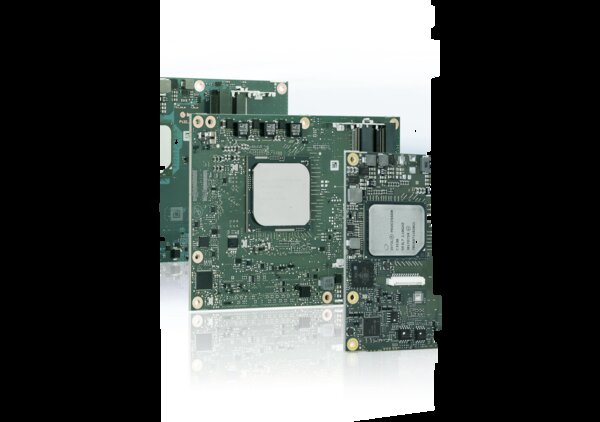
Security, flexibility and compatibility are success factors for applications in the environment of Industry 4.0 and the "Internet of Things" (IoT). Standards are of central importance for digitization in this area. They ensure a smooth "handshake" between operational technology (OT) and classic IT. In the industrial environment, standards also enable a continuous flow of data and ensure the compatibility of different areas. Standards are the basis for modular solutions that enable individual customer-specific systems for a wide range of industries. Hardware with embedded technologies serves as a "commodity", on which the IP is mapped as software. This creates flexible, scalable environments. Customers thus benefit from a faster time-to-market, lower total cost of ownership, a longer product life cycle and holistically optimised applications.
In this way, new data-based business models can be generated thanks to standards in a wide range of industries - quickly and cost-effectively. Just as dynamic markets demand. This enables companies to strengthen their competitive position and protect investments.
Embedded Computing: 2020 brings new standards
New solutions are developing in the wake of digitisation - this is especially true for the field of embedded systems. Proven solutions often work side by side with new developments. Standardised Computer-on-Modules for the development of embedded systems, for example, have long proved their worth. They represent a compromise between an "out of the box" solution and a complete development. New processor and memory technologies as well as new standards ensure further dynamic developments. Kontron is actively shaping these. With COM-HPC™, SMARC Module 2.1 and OSM (Open Standard Module), there are three new standards in 2020. The first products based on these standards will be delivered this year. While COM-HPC™ represents an upward scaling in terms of performance, OSM is an extension for low-end/high-volume applications. SMARC Module 2.1 offers new functionalities for the medium performance segment.
COM Express
For many years to come, the highly scalable COM Express® Type 7 (as well as all other COM Express® types) will continue to be a best-seller, especially when smaller footprint, power savings, and cost are primary factors. Type 7 o ers considerable scope for combining powerful processing with high speed Ethernet connectivity and high data throughput. It has the power and exibility of multicore parallel processing, 4x 10 Gbit network inter- faces, and multiple PCI Express® lanes. NC-SI sideband signals also provide the ability to perform remote diagnostics and pre-emptive maintenance in combination with a Board Management Controller (BMC) on the base- board.
COM Express® Type 7 perfectly addresses a broad spectrum of IIoT applications requirements, including:
- Value-oriented optimized performance/watt imple- mentations with Ethernet connectivity e.g. Network routers, Gateways, and Microservers
- Edge Cloud and Fog servers
- High bandwidth Mobile Communications: at the edge of carrier base stations
- Industrial: machine temperature monitoring; camera inspection; intelligent power control; indoor and outdoor small cell applications
Kontron’s powerful COM Express® Type 7 edge HPC server module portfolio (COMe-bBD7, COMe-bDV7 and COMe- cDV7) provides a broad feature variety and high scalability for various workload and performance application requirements:
https://www.kontron.com/products/boards-and-standard-form-factors/com-express
COM-HPC™: Performance Turbo for industrial environments
COM-HPC™ was developed especially for high-end computing and complements the existing COM Express® standard. This standard was developed explicitly for the special requirements of industrial edge computing. Here the hunger for high bandwidths and excellent performance is extremely high. This is especially true when AI, Machine Learning and 5G come into play. The fast exchange of information between edge and cloud can only work if these basic conditions are met.
Modules based on COM-HPC™ provide exactly the computing power required by the growing flood of data in an industrial environment. Edge gateways in Edge servers must carry out evaluations directly at the data source and deliver well-founded results. This only works with a strong infrastructure. COM-HPC™-based modules enable the use of 100GbE network connections. Kontron uses two new high-speed connectors with 4x100 pins each. This is the prerequisite for full steam ahead in the Industry 4.0 environment.
SMARC - a new champion in the club of industrial standards
Smart Mobility Architecture Module (SMARC) has made a significant contribution to the development of innovative embedded computing solutions with low power consumption. The driving force behind the further development of the SMARC 2.1 module standard was the "Internet of Things" (IoT). The specification 2.1.extends the standard with new functions and interfaces. These include SERDES support, which enables additional Ethernet interfaces, for example. This is particularly important for stronger networking at the edge. The extension to up to 4 interfaces for the camera technology MIPI-CSI, enables the use of SMARC as "AI on Module".
SMARC 2.1 offers a wide range of new application options for different areas. Here the spectrum ranges from monitoring to robotic surgery and forensics. Another field of application is intelligent traffic systems, which are decisive for the realisation of "Smart City" concepts.
OSM: The future belongs to soldered System-on-Modules
The triumphal march of IoT applications is increasing the demand for modules with which machines, sensors and actuators can be integrated easily and cost-effectively. This is exactly the fitting application area for System-on-Modules (SoM). Cost sensitivity and the miniaturisation of components and the desire for more functionality collide in this environment. The new Open Standard Module (OSM) provides the right solution.
OSM is designed for soldered SoMs that can be completely machined. OSM improves both handling and assembly as well as testing. The specifications of OSM refer to size, footprint, pin assignment and interfaces. Four module formats based on each other are provided for scaling.
With new standards into the industrial future
Standards are important building blocks for a successful future of industrial applications and not least for edge computing. Big-Data processes that emerge here are hungry for bandwidth and demand high performance to avoid a break in the processing of data and information.
Without standards that ensure seamless communication and compatibility, the enormous challenges that Industry 4.0 poses to companies cannot be overcome. Kontron will continue to meet the challenges of the future with its product developments. As the editor of the COM-HPC specification, we are among the driving forces behind the COM-HPC standard. Kontron is also intensively involved in the further development of COM Express® and is a member of PICMG®, the consortium that oversees the COM Express® specification.
Are you already using applications for Industry 4.0 and IoT? What experience have you had with your solutions?


{{comment.comment}}